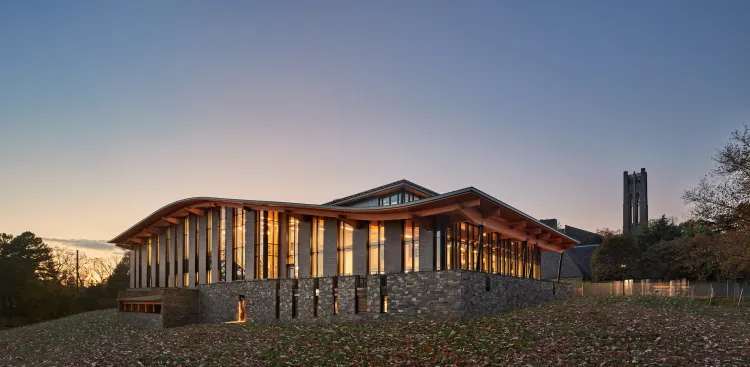Swarthmore College "Shows How We Can Live Without Fossil Fuels," Says Philadelphia Inquirer

Swarthmore’s new Dining Center is the heart of a geoexchange system, part of an ambitious plan to bring the College closer to carbon neutrality by 2035 — and make it a model for other institutions that want to develop their own renewable energy initiatives.
For the full-on Hogwartian experience, few American campuses can match the moment when you step off the SEPTA train at Swarthmore College and gaze up at the immense Victorian pile presiding at the top of the hill. A path lined with towering white oaks and flanked by rolling lawns immediately summons you to the front door.
That vista is Swarthmore’s signature, regularly pictured in the college’s promotions. But last year, Swarthmore did something that, on first glance, would have horrified its Quaker founders and generations of alumni (not to mention, Harry Potter fans). It tore up a big swathe of that great lawn and proceeded to carve a checkerboard of 800-foot-deep tunnels into the hillside. The grass will eventually be restored, but only after eight college buildings are connected into a geoexchange loop that can provide heat and air-conditioning without energy from fossil fuels.
The heart of the system is a remarkable, swoop-roofed dining hall constructed with a mass timber frame — a low-carbon alternative to the usual steel skeleton — and equipped with all electric appliances. With these two projects, Swarthmore has taken a giant step toward its goal of becoming carbon neutral by 2035. That means no more oil, gas or coal-generated power. Just renewables.
...
The College knew that its century-old central steam plant was coming to the end of its useful life. The question was whether to replace it with a conventional, gas-powered plant or invest in an expensive, but more sustainable, geoexchange system.
Geoexchange systems have become an increasingly popular way to heat and cool buildings without using carbon fuels. The system, which is essentially a big grid of underground pipes attached to heat pumps, has often been compared to a bank. In the summer, the exchange works like a conventional air conditioner, by sucking heat out of buildings. But instead of spewing that hot air into the atmosphere — and contributing to global warming — it channels it into the earth, where it is stored in the pipe network. In the winter, the warm air is pumped back into the buildings.
Read the full column by Inga Saffron, the Inquirer's Pulitzer Prize-winning architecture critic



